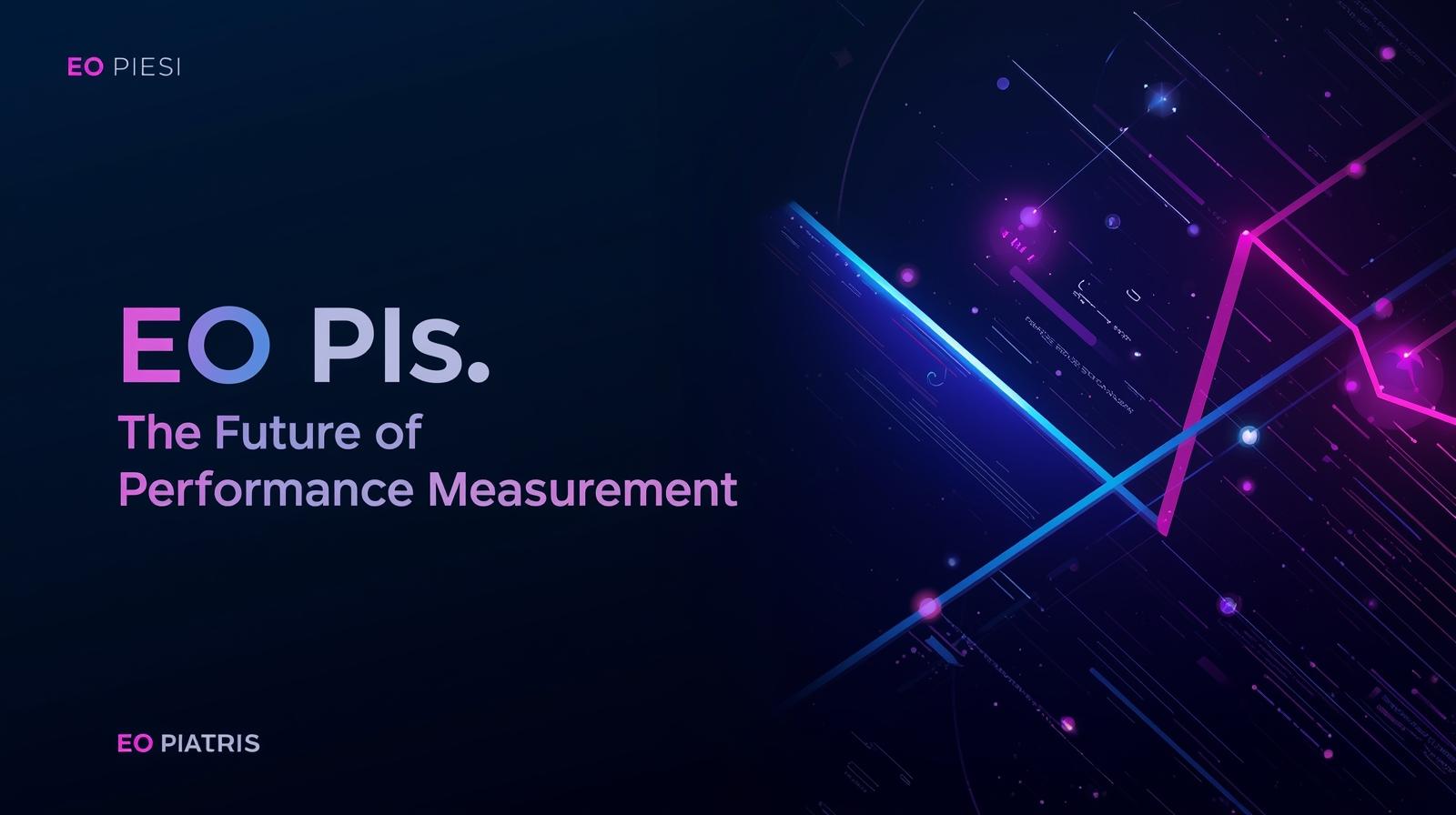In today’s fast-paced business environment, performance measurement is more critical than ever. Traditional Key Performance Indicators (KPIs) have long been the standard for assessing business performance, but with evolving market dynamics, there’s a need for a more comprehensive and outcome-based metrics approach. Enter EO Pis (Experience Optimization Performance Indicators), a transformative tool that provides businesses with a deeper understanding of their effectiveness. This article will explore EO Pis, its components, benefits, challenges, and the future of this powerful framework.
What Is EO Pis?
EO Pis, or Experience Optimization Performance Indicators, are a modern approach to performance tracking. Unlike traditional KPIs, which focus on outputs such as sales numbers or production rates, EO Pis concentrate on outcomes. Specifically, EO Pis evaluates how well customer experiences and interactions align with organizational goals, providing insights into areas like user engagement, satisfaction levels, and brand loyalty.
By analyzing data across various touchpoints, EO Pis helps organizations understand the direct impact of their strategies on customer behavior. This enables businesses to adapt in real-time, optimizing experiences to improve overall performance and customer satisfaction.
Why EO Pis Matters in Modern Business
As businesses strive for agility and innovation in an increasingly competitive landscape, EO Pis are becoming a crucial tool for success. The shift towards data-driven strategies, where real-time analytics are key, makes EO Pis an indispensable asset. Unlike traditional methods that rely on retrospective analysis, EO Pis provide immediate feedback, allowing businesses to adjust strategies and operations dynamically.
Moreover, the growing emphasis on customer-centric approaches makes EO Pis particularly relevant. These indicators not only track internal metrics but also align business goals with customer satisfaction and engagement levels, ensuring that businesses remain responsive to the evolving needs and expectations of their target audiences.
Key Components of EO Pis Systems
EO Pis are built on several key components that make them effective in driving performance:
- Data Sources: Reliable data sources are the foundation of any EO Pis system. Businesses need accurate, real-time data from multiple sources, including customer feedback, social media, and transactional data, to make informed decisions.
- Metrics: These metrics define what success looks like in an organization. Key metrics track performance and measure progress toward business objectives and customer engagement.
- Visualization Tools: Visualization tools, such as dashboards or graphs, transform complex data into easily understandable visual formats. This helps stakeholders quickly grasp insights and take appropriate actions.
- Analytics: Machine learning (ML) and predictive analytics play a crucial role in EO Pis, offering valuable insights into future trends and behaviors, which can help businesses stay ahead of the curve.
EO Pis vs Traditional KPIs – Key Differences
EO Pis and traditional KPIs differ significantly in their approach to performance measurement. KPIs typically focus on quantitative outputs like revenue, customer acquisition rates, and production efficiency. While these are important, they fail to account for the qualitative aspects that drive customer loyalty and long-term success.
In contrast, EO Pis focuses on outcome-based metrics, offering a more holistic view of business performance. They measure the effectiveness of customer interactions, ensuring that businesses can track not only the results but the experiences that lead to those results. This shift from output-based to outcome-based metrics allows organizations to refine strategies, improve customer journeys, and enhance overall satisfaction levels.
Benefits of Using EO Pis in Any Organization
Integrating EO Pis into an organization can yield several powerful benefits:
- Deeper Insights into Performance: EO Pis provides a comprehensive view of performance by focusing on outcomes like customer satisfaction, engagement, and loyalty, rather than just financial metrics.
- Enhanced Adaptability: Real-time insights enable businesses to quickly adapt to changing market conditions or shifts in customer preferences, ensuring they remain competitive.
- Alignment with Organizational Goals: By focusing on key experiences and outcomes, EO Pis helps align the entire organization toward shared objectives, fostering team collaboration and accountability across departments.
- Improved Decision-Making: EO Pis provide actionable insights that can drive informed decision-making, whether it’s refining marketing strategies or optimizing resource management.
Real-World Use Cases of EO Pis
EO Pis have been successfully applied across various industries:
- Healthcare: In healthcare, EO Pis can track patient outcomes, optimize treatment plans, and improve overall patient care. By measuring the patient experience, healthcare providers can adapt their approaches to ensure better outcomes.
- Retail: In the retail sector, EO Pis helps businesses analyze customer behavior in real time. This data helps tailor marketing strategies and enhance customer experiences, ultimately driving sales.
- Manufacturing: Manufacturers benefit from EO Pis by monitoring production efficiency and product quality. By identifying bottlenecks quickly, organizations can streamline operations and reduce costs, improving manufacturing efficiency and cost reduction.
- Technology: In tech companies, EO Pis can track user experience with products, providing insights into product usability and customer satisfaction. This can guide product development and customer support efforts.
Challenges in Implementing EO Pis
While EO Pis offer numerous advantages, their implementation is not without challenges:
- Data Integration: Combining existing data sources with EO Pis systems can be complex, particularly when dealing with disparate data sets across different departments or platforms.
- Stakeholder Resistance: Employees and stakeholders may resist adopting EO Pis, particularly if they don’t fully understand the system or its benefits. Effective communication and training are essential for overcoming this barrier.
- Resource Allocation: Implementing EO Pis requires time, money, and skilled personnel. Businesses may face resource management constraints, making it difficult to deploy these systems effectively.
- Data Overload: The vast amount of data generated can sometimes overwhelm organizations, leading to difficulties in identifying the most relevant insights. Careful metrics analysis and filtering are crucial to avoid information paralysis.
Best Practices for Deploying EO Pis
To ensure the successful deployment of EO Pis, businesses should follow these best practices:
- Define Clear Objectives: Establish specific, measurable goals that align with the overall business strategy. This ensures that EO Pis track the right outcome-based metrics.
- Engage Stakeholders: Involve key stakeholders from the start to ensure buy-in and support throughout the process. This will facilitate smoother implementation and greater adoption.
- Choose the Right Metrics: Select the most relevant metrics for tracking customer experience and business success. Focus on those that will provide actionable insights.
- Use Visualization Tools: Dashboards and graphs can simplify complex data, making it easier for stakeholders to interpret and act on insights.
- Continuous Review and Adjustment: Regularly assess the relevance of your EO Pis and make adjustments as necessary to keep them aligned with evolving business goals and market conditions.
Future Trends: What’s Next for EO Pis?
The future of EO Pis looks promising, with several trends shaping their evolution:
- Integration with AI and Machine Learning: As artificial intelligence (AI) and machine learning (ML) technologies continue to evolve, EO Pis will become even more powerful. Predictive analytics and automated decision-making will enhance the accuracy and efficiency of these performance indicators.
- Real-Time Data Collection: The integration of EO Pis with real-time data collection tools will allow businesses to respond faster to changes in customer behavior, market conditions, and operational needs.
- Personalization: EO Pis will increasingly be tailored to specific industries, helping businesses create highly personalized strategies that meet the unique needs of their customers.
EO Pis in Cultural and Digital Language
EO Pis are not only transforming business operations but also influencing digital and cultural language. As organizations place greater emphasis on customer experiences, terms like “user-centric” and “outcome-based” are becoming more prevalent in business discourse. This shift reflects a growing understanding of the importance of qualitative factors in achieving long-term success.
Common Misunderstandings Around EO Pis
There are several misconceptions about EO Pis that businesses need to address:
- EO Pis are just another form of KPIs: While EO Pis and KPIs are related, EO Pis go beyond traditional KPIs by focusing on outcomes and customer experiences rather than just outputs.
- EO Pis are too complex to implement: While integrating EO Pis may require time and effort, the process can be streamlined with the right tools and a clear strategy.
- EO Pis are only for large businesses: EO Pis are scalable and can be adapted to businesses of all sizes, offering valuable insights for organizations of any scale.
When is EO Pis Not Suitable or When Should You Avoid Using It?
EO Pis may not be suitable in certain circumstances, such as:
- For Small Teams with Limited Data: If a business has limited resources or data, implementing EO Pis may not be practical. In these cases, simpler performance metrics may suffice.
- In Highly Regulated or Audit-Driven Environments: Organizations in industries with strict regulatory requirements may find it difficult to incorporate EO Pis into their existing frameworks.
- When Data Quality is Poor: EO Pis rely on accurate, high-quality data. If a business struggles with data consistency or quality, implementing EO Pis may lead to inaccurate insights.
Conclusion
EO Pis represent a paradigm shift in how businesses measure performance. By focusing on outcomes, customer experiences, and real-time insights, EO Pis provides a more comprehensive and actionable approach to performance management. As businesses continue to prioritize agility and adaptability, EO Pis will become an essential tool for driving success. By understanding their components, benefits, and challenges, organizations can harness the power of EO Pis to optimize business performance and stay ahead of the competition.
Newtopy: Building Smarter Digital Communities and Brands
FAQs
What are EO Pis?
EO Pis Experience Optimization Performance Indicators are metrics that measure the effectiveness of customer interactions and business outcomes.
How do EO Pis differ from traditional KPIs?
EO Pis focuses on outcomes and customer experiences, while traditional KPIs measure outputs like sales and revenue.
What industries benefit from EO Pis?
EO Pis are beneficial in healthcare, retail, manufacturing, and technology industries, enhancing customer satisfaction and operational efficiency.
What is the main advantage of using EO Pis?
EO Pis provides deeper insights into customer behavior and improves decision-making by focusing on qualitative and outcome-based metrics.
How do EO Pis improve decision-making?
By providing real-time insights, EO Pis enable organizations to make data-driven decisions and quickly adapt to market changes.
Can EO Pis be used by small businesses?
Yes, EO Pis are scalable and can be tailored to businesses of any size, offering valuable insights for organizations with limited data.
How will EO Pis evolve in the future?
As AI and machine learning technologies advance, EO Pis will provide even more accurate predictions and personalized strategies.

